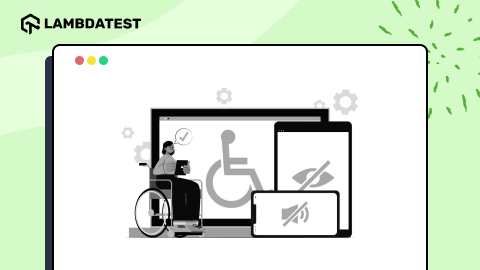QA’s and Unit Testing – Can QA Create Effective Unit Tests
Amy E Reichert
Posted On: December 14, 2022
![]() 12342 Views
12342 Views
![]() 8 Min Read
8 Min Read
Unit testing is typically software testing within the developer domain. As the QA role expands in DevOps, QAOps, DesignOps, or within an Agile team, QA testers often find themselves creating unit tests. QA testers may create unit tests within the code using a specified unit testing tool, or independently using a variety of methods.
The overall goal is to leverage the benefits of unit testing to produce a higher-quality application. What role creates the test is less important. For QA testers, understanding and having the skill to create effective unit tests is a bonus. QA tester’s skills need to be multidimensional as well as adaptable to retain business value across the full spectrum of software development. The more tasks a QA can perform, the better the job opportunities available.
Why is unit testing important and how does it benefit application quality?
Unit testing is important because it provides the first opportunity to test software application code. By creating and executing unit tests, software testers can effectively assess the quality of code right from the start of the coding effort. Unit tests provide code isolation that allows for issues or defects to be quickly identified, fixed, and retested. The more defects fixed early in the coding process, the more costs are reduced by having to fix errors at later stages or just before, or right after a release.
Key Takeaways:
- What is Unit Testing?
- What are the basic concepts of unit testing?
- How can QA testers create unit tests?
- What are alternative options for creating unit tests?
- Learn how QA testers can create effective unit tests with or without code.
This guide describes how QA testers can create unit tests in a variety of ways to test code from beginning to end and reap the benefits of finding defects early and often for improved application quality.
What is Unit Testing?
Unit testing is a type of software testing where individual and testable code components are tested independently. Unit tests create a repeatable test suite that can be executed throughout the development lifecycle. The advantages of unit testing include being able to test as you code. After all, the further you get through the coding process, the more complex the testing paths get. Writing unit tests simplifies testing each testable code component before the code becomes complex.
Unit testing provides a step-by-step method of gaining an understanding of how a functional set of code works. Many teams also use unit testing as documentation. Documentation on code functionality is created by adding the details on the libraries used or the coding framework employed. Granted, it’s not a full set of documentation but it gives developers and QA testers an understanding of the application’s implementation and functionality.
Delve into our top Unit Testing Interview Questions guide, designed to help you excel in unit testing interviews. It covers a wide range of topics, from syntax to advanced techniques, with detailed solutions.
Other advantages of unit testing include:
- Creates a re-usable regression suite
- Improves application software quality consistency
- Enables accurate defect or issue debugging and tracking
- Isolates defects to specific code components for easier debugging and repair
- Aids in design improvements or establishes the possibilities and limitations of a design
Unit testing benefits application software quality by creating basic documentation and enabling frequent testing throughout the development cycle. However, unit testing is only for single code components and has a few disadvantages.
Disadvantages of unit testing include:
- Limited to code components so cannot catch any defects within functional, integrated, or system test scenarios
- Time-consuming to create and manage manually
- Adds to test maintenance when automated tests are used
- Automated tests also require failure analysis to determine defect validity
- Requires mocks and stubs to simulate dependent connections like APIs and databases
Learn About Kotlin Unit Testing.
What are the Basic Concepts of Unit Testing?
Unit testing is the smallest testable part of an application that can execute independently. Code components are defined by the type of programming used and the architecture employed. Unit tests may test a line or more of code, a class, a single function, a procedure, or even an entire feature code set.
As a QA tester responsible for creating unit tests, the first step is to identify testable components and the code structure. Next, use the AAA (Arrange, Act, Assert) method. Create unit tests that start by initializing the component to be tested and then perform an action. Once an action is executed, then the test must include an assertion or result. In other words, unit tests must include the test execution and the ability to quantify the result as pass or fail.
When developing unit tests keep the following test characteristics in mind:
- Each test must be able to execute independently without any dependency on other tests or the test execution order
- Ensure unit tests truly pass or fail by including negative testing to ensure the test fails when it should
- Use specific data sets for input and avoid using random data input
- Unit tests must be repeatable and generate the same output in each execution
- Create unit tests that are self-validating so there is no manual interpretation or analysis necessary
Unit testing may require mocking to test dependencies. Mocking helps to simulate functions of code not yet created. If mocking is necessary for effective testing work with developers to help create mocking or code stubs to use for each function needed.
How can QA Testers create Unit Tests?
QA testers writing unit tests will need access to the codebase and coding tool(s). Additionally, unit test development may require a unit testing tool. There are multiple tools that assist with unit test creation. Check the development tool and architecture used first to see if a unit testing tool is included by default. QA testers need time to learn and understand the tool before creating unit tests. The time spent learning benefits the team in the long run when QA testers create higher-quality unit tests that are valid, effective, and easy to maintain and execute repeatedly.
Sample list of unit testing tools includes (small sampling only, search for more alternatives):
- Junit – Free testing tool used for Java
- Nunit – Popular unit testing framework for .NET
- JMockit – Expansive and adaptable tool for multiple coding languages
- EMMA – Open-source toolkit for testing Java
- PHPUnit – Used for PHP that enables pre-defining assertion methods to match code behavior
- Postman – Popular tool for API testing
QA testers can also create unit tests outside of the codebase. Unit tests outside the code? How is that possible?
What are Alternative Options for Creating Unit Tests?
Unit testing does not always have to mean tests built into the codebase. Many QA testers create effective unit tests using the following methods:
- Black box functional test snippets
- Smoke test suites
- API tests
- Automated tests using a modular test design
QA testers can create a series of black box functional tests for each function or code component when enough coding exists to perform the test in the application. Testing can be awkward at first when testers are used to system or end-to-end workflow test execution. Testing using small, specific tests per function is possible and serves to create a reusable base for later test case development and execution.
Smoke test suites are simplified tests that test the smallest function possible for each entity or functional area. Smoke test suites can be manual or automated to ensure defects are not found in the basic application functionality. Smoke tests are repeatable and easily debugged as specific units when defects are found.
API test creation is a form of unit testing. Creating manual or automated API tests creates an easy-to-maintain method of unit testing all application APIs continuously. In the same manner, an automated test tool can be used to create small, specific tests in a modular design. Modules can then be executed singly or combined as the code matures. Modular automated tests build a stable foundation of application functions that can be leveraged and reused for later testing efforts.
Unit testing ensures application quality throughout the software development process. Unit tests can be re-used in many ways including as smoke test suites or even an efficient form of regression testing individual functions. Even though unit testing does not find all defects and cannot be used for system or end-to-end testing, it builds in application quality from the start of the project.
Unit testing finds defects early when they are easier to isolate and repair. The sooner defects are found and fixed, the higher the application quality by release. When developers cannot perform unit testing, consider getting the QA testing team involved. Determine the unit testing method that works for the application, whether it’s traditional unit testing built into the codebase, or executed as API tests, black box testing, smoke test suites, or modular automated tests. QA testers can create effective unit testing that builds business value and better ensures software application from the beginning of the project through to the release.
Got Questions? Drop them on LambdaTest Community. Visit now












